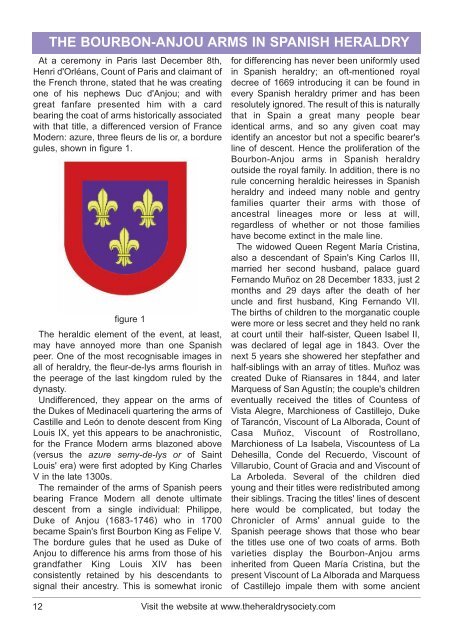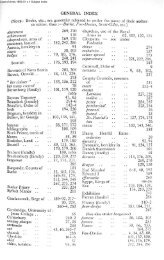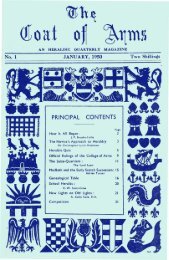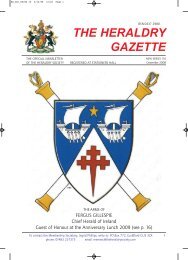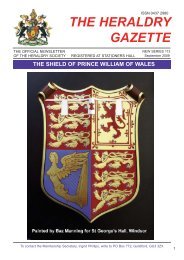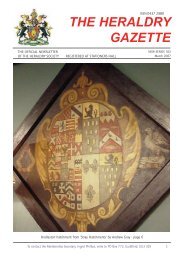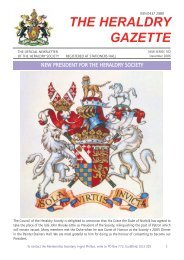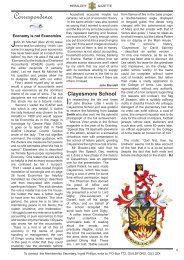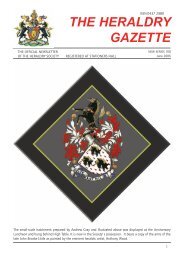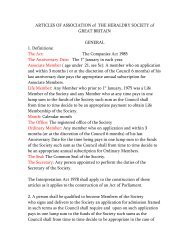Create successful ePaper yourself
Turn your PDF publications into a flip-book with our unique Google optimized e-Paper software.
12<br />
THE BOURBON-ANJOU ARMS IN SPANISH HERALDRY<br />
At a ceremony in Paris last December 8th,<br />
Henri d'Orléans, Count of Paris and claimant of<br />
the French throne, stated that he was creating<br />
one of his nephews Duc d'Anjou; and with<br />
great fanfare presented him with a card<br />
bearing the coat of arms historically associated<br />
with that title, a differenced version of France<br />
Modern: azure, three fleurs de lis or, a bordure<br />
gules, shown in figure 1.<br />
figure 1<br />
<strong>The</strong> heraldic element of the event, at least,<br />
may have annoyed more than one Spanish<br />
peer. One of the most recognisable images in<br />
all of heraldry, the fleur-de-lys arms flourish in<br />
the peerage of the last kingdom ruled by the<br />
dynasty.<br />
Undifferenced, they appear on the arms of<br />
the Dukes of Medinaceli quartering the arms of<br />
Castille and León to denote descent from King<br />
Louis IX, yet this appears to be anachronistic,<br />
for the France Modern arms blazoned above<br />
(versus the azure semy-de-lys or of Saint<br />
Louis' era) were first adopted by King Charles<br />
V in the late 1300s.<br />
<strong>The</strong> remainder of the arms of Spanish peers<br />
bearing France Modern all denote ultimate<br />
descent from a single individual: Philippe,<br />
Duke of Anjou (1683-1746) who in 1700<br />
became Spain's first Bourbon King as Felipe V.<br />
<strong>The</strong> bordure gules that he used as Duke of<br />
Anjou to difference his arms from those of his<br />
grandfather King Louis XIV has been<br />
consistently retained by his descendants to<br />
signal their ancestry. This is somewhat ironic<br />
for differencing has never been uniformly used<br />
in Spanish heraldry; an oft-mentioned royal<br />
decree of 1669 introducing it can be found in<br />
every Spanish heraldry primer and has been<br />
resolutely ignored. <strong>The</strong> result of this is naturally<br />
that in Spain a great many people bear<br />
identical arms, and so any given coat may<br />
identify an ancestor but not a specific bearer's<br />
line of descent. Hence the proliferation of the<br />
Bourbon-Anjou arms in Spanish heraldry<br />
outside the royal family. In addition, there is no<br />
rule concerning heraldic heiresses in Spanish<br />
heraldry and indeed many noble and gentry<br />
families quarter their arms with those of<br />
ancestral lineages more or less at will,<br />
regardless of whether or not those families<br />
have become extinct in the male line.<br />
<strong>The</strong> widowed Queen Regent María Cristina,<br />
also a descendant of Spain's King Carlos III,<br />
married her second husband, palace guard<br />
Fernando Muñoz on 28 December 1833, just 2<br />
months and 29 days after the death of her<br />
uncle and first husband, King Fernando VII.<br />
<strong>The</strong> births of children to the morganatic couple<br />
were more or less secret and they held no rank<br />
at court until their half-sister, Queen Isabel II,<br />
was declared of legal age in 1843. Over the<br />
next 5 years she showered her stepfather and<br />
half-siblings with an array of titles. Muñoz was<br />
created Duke of Riansares in 1844, and later<br />
Marquess of San Agustín; the couple's children<br />
eventually received the titles of Countess of<br />
Vista Alegre, Marchioness of Castillejo, Duke<br />
of Tarancón, Viscount of La Alborada, Count of<br />
Casa Muñoz, Viscount of Rostrollano,<br />
Marchioness of La Isabela, Viscountess of La<br />
Dehesilla, Conde del Recuerdo, Viscount of<br />
Villarubio, Count of Gracia and and Viscount of<br />
La Arboleda. Several of the children died<br />
young and their titles were redistributed among<br />
their siblings. Tracing the titles' lines of descent<br />
here would be complicated, but today the<br />
Chronicler of Arms' annual guide to the<br />
Spanish peerage shows that those who bear<br />
the titles use one of two coats of arms. Both<br />
varieties display the Bourbon-Anjou arms<br />
inherited from Queen María Cristina, but the<br />
present Viscount of La Alborada and Marquess<br />
of Castillejo impale them with some ancient<br />
Visit the website at www.theheraldrysociety.com


